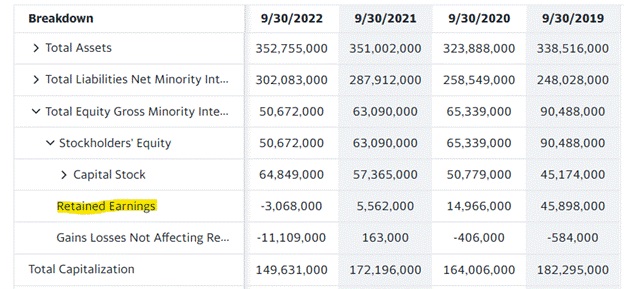How Are Retained Earnings Calculated?
A company’s retained earnings can be calculated as follows:
Retained earnings = Net Profit - Dividends
Where:
Net Profit = Sales - Fixed costs - Variable costs - Taxes
The following are the elements involved with determining retained earnings:
- Sales - The amount of revenue a company has generated from the sales of goods and services to its customers.
- Fixed or indirect costs - Expenses that are generally known and regularly paid to vendors and suppliers such as rent, insurance, administrative support, etc. This category also includes costs not classified as COGS. COGS are costs that can be directly attributed to the production or acquisition of units sold.
- Variable or direct costs - Expenses that can be classified as COGS. This includes inventory, production salary, manufacturing overhead, etc.
- Taxes - The amount of corporate income tax levied by federal and state governments on business profits.
- Dividends - A portion of the company’s earnings that are distributed back to the shareholders (i.e., the owners of the company). For most companies, this is done once per quarter.
How Are Retained Earnings Used?
Reporting a company’s retained earnings is important because it can reveal many key characteristics of its viability and financial health.
For instance, a company that has retained earnings can use its equity to expand by purchasing new equipment or adding another business division (either through acquisition or development). If the company needs to borrow money for these initiatives, banks will also look to their debt-to-equity ratio when underwriting the loan. The company’s amount of retained earnings will have a direct effect on how much the bank is willing to lend (typically about three or four times what the company has in terms of equity).
Retained earnings also add to a company’s book value. Book value is the total amount of assets a company has on its balance sheet minus accumulated depreciation. Book value is one of the many ways that investors and market analysts measure a company's worth. The greater its retained earnings, the greater its book value.
In general, retained earnings can also speak to the financial maturity of a company. Businesses that have been in operation for several years may not need to have as many retained earnings and instead might put this cash to use or increase dividend payments.
Revenue vs. Retained Earnings
Sometimes a business’s retained earnings will get confused for revenue. However, these two values represent different aspects of its financial reporting.
Revenue, or more specifically, net revenue (i.e., gross revenue minus COGS) is the amount of money a company has earned before taking into consideration operating and capital expenses. This figure is helpful for keeping track of costs and ensuring profit margins. However, it doesn’t provide the full picture.
Retained earnings, on the other hand, reveal more about a company’s full spectrum of expenses. In addition to COGS, it also includes other factors that will make an impact on profitability such as taxes, dividends, depreciation, etc.
Where Are Retained Earnings Reported?
Retained earnings are a standard accounting item and can be found on the company’s balance sheet. It generally appears in the shareholders’ equity section of the balance sheet. Below is a snapshot of the retained earnings for tech giant company Apple (ticker: AAPL).

Image source: Yahoo Finance
Retained earnings are added to the total equity section and not the assets because they essentially become part of the company’s equity. This is alongside the money that was initially invested by shareholders. When retained earnings are added to the balance sheet year after year, they become what’s known as accumulated profits.
The Bottom Line
Retained earnings are the profits that a company has after subtracting away all of its expenses from sales. This includes fixed costs, variable costs, taxes, and dividends.
Retained earnings can be used to gauge the health of a company, including its ability to repay debt or consider expansion. They can also be used to demonstrate the maturity of the company's financial standing.
Retained earnings are found on the balance sheet of any publicly traded company under the shareholder's equity section.
